Burralow Creek campground and picnic area
Lower Grose Valley area in Blue Mountains National Park
Learn more
Learn more about why this area is special
Burralow Creek campground and picnic area is in Lower Grose Valley area. Here are just some of the reasons why this park is special:
A sanctuary for plants and animals
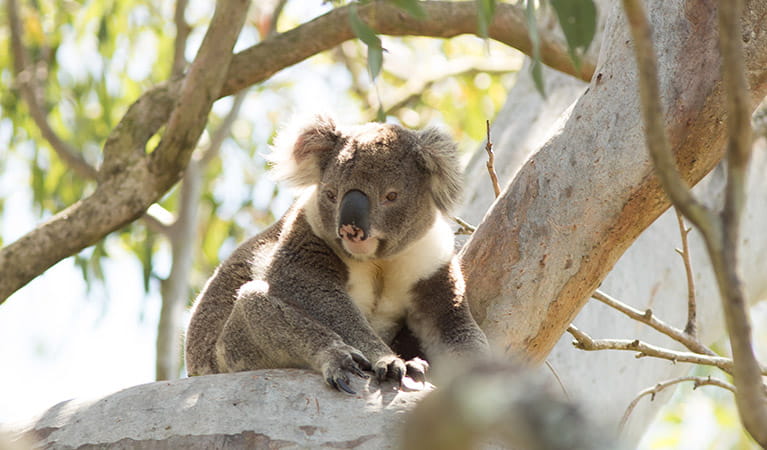
The diverse environments of the Lower Grose Valley are a sanctuary for many rare and threatened species. Endangered plants include sparse heath, unique to the lower Grose River area, leucopogons, and the fluoro-yellow Gordon’s wattle. Conservation efforts and plentiful grey gums support one of the few known koala colonies in the Hawkesbury. Tall forests of blue gum and mountain gum are home to vulnerable yellow-bellied gliders. Camp overnight at Burralow Creek campground and you may hear the calls of some of Australia’s rarest forest owls, including the southern boobook owl. Burralow’s peat swamps, 1 of 3 threatened ecological communities (TECs) in this area, are home to the nationally endangered giant dragonfly. In the damp surrounds of Transit of Venus walk’s waterfalls, the Blue Mountains water skink can be found.
- Vale of Avoca lookout Vale of Avoca lookout offers glorious views across the deep gorges and wilderness of the Lower Grose Valley, in World Heritage-listed Blue Mountains National Park, near Richmond.
In the footsteps of early tourists
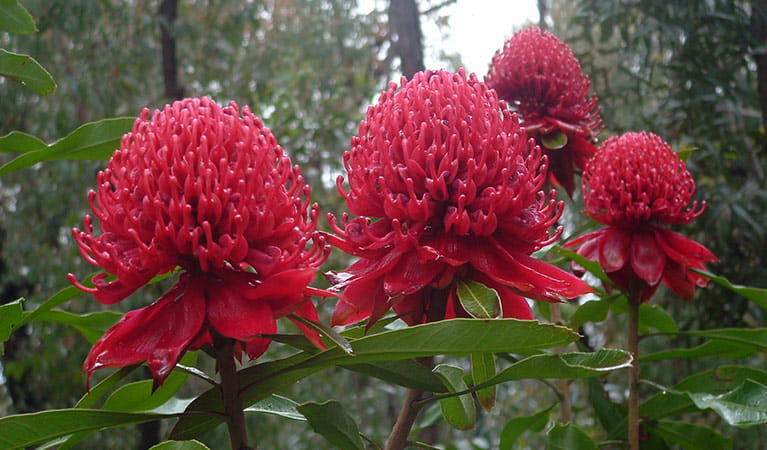
Follow in the footsteps of Victorian-era tourists drawn to the fresh mountain air, pretty waterfalls, and native wildflowers including waratahs. Walk along Transit of Venus walking track from Woodbury Street in Woodford, and stop for a picnic at Edith Falls. Enjoy the natural beauty of Burralow Creek, near Kurrajong Heights (4WD access only). Burralow Creek has a rich history spanning tens of thousands of years of habitation by the traditional Darug People, to early colonial attempts at farming rice, and later cattle farming and mining efforts.
Ancient landscapes
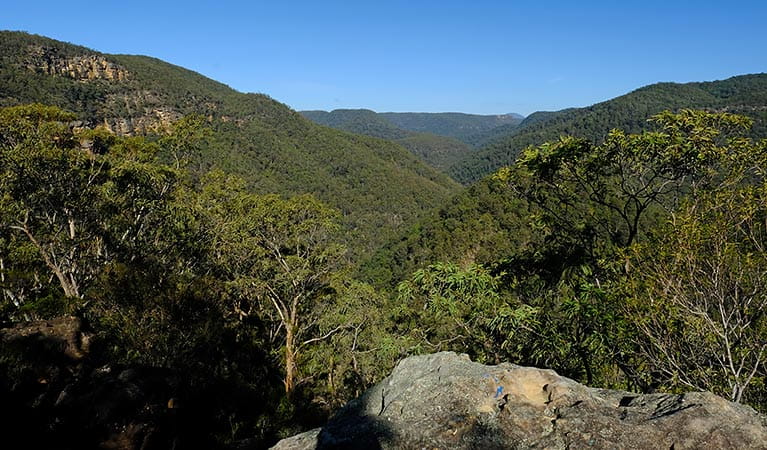
Stand atop Vale of Avoca lookout and you’ll get a sense of the forbidding terrain faced by early European explorers. The wide valleys of the upper Grose Valley narrow into deep, V-shaped gorges in its lower reaches, formed over millennia by geological uplift and erosion. Stunted heathland covers the exposed escarpment, while tall eucalypt forests crowd the valleys. In protected pockets you’ll find microclimates like upland swamps, and ancient rainforest from the Gondwana days.
- Vale of Avoca lookout Vale of Avoca lookout offers glorious views across the deep gorges and wilderness of the Lower Grose Valley, in World Heritage-listed Blue Mountains National Park, near Richmond.
Greater Blue Mountains World Heritage Area
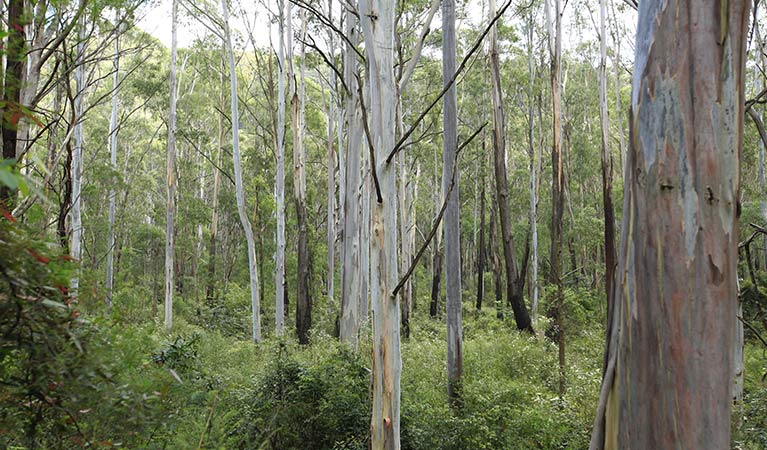
Blue Mountains National Park is 1 of 8 national parks and reserves that make up the Greater Blue Mountains World Heritage Area (GBMWHA). In 2000, UNESCO recognised the area's outstanding geology, biodiversity, and Aboriginal significance. The GBMWHA lies within the Country of the Darug, Gundungurra, Wiradjuri, Darkinjung, Wanaruah and Dharawal People. With 1 million hectares of rugged plateaux, sheer cliffs, deep gorges, it protects unique ecosystems teeming with rare plants and animals. Over 95 species of eucalypt trees have evolved here over millions of years, making it the most diverse eucalypt forest in the world. The Lower Grose Valley area provides some of the easiest access to the park’s only declared wilderness, the Grose Wilderness, and its pristine river.
- Vale of Avoca lookout Vale of Avoca lookout offers glorious views across the deep gorges and wilderness of the Lower Grose Valley, in World Heritage-listed Blue Mountains National Park, near Richmond.
Plants and animals protected in this park
Animals
-
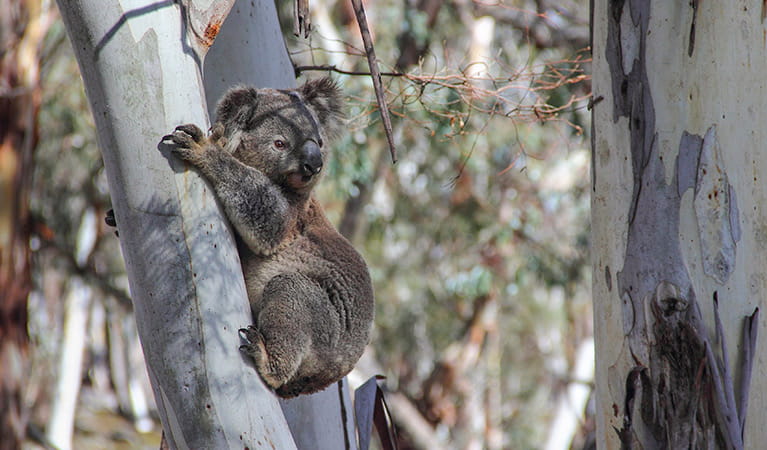
Koala (Phascolarctos cinereus)
One of the most renowned Australian animals, the tree-dwelling marsupial koala can be found in gum tree forests and woodlands across eastern NSW, Victoria and Queensland, as well as in isolated regions in South Australia. With a vice-like grip, this perhaps most iconic but endangered Australian animal lives in tall eucalypts within a home range of several hectares.
-
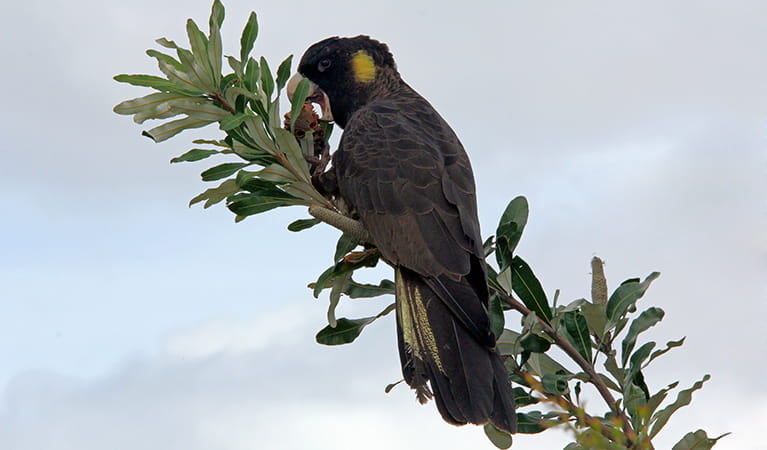
Yellow-tailed black cockatoo (Calyptorhynchus funereus)
The yellow-tailed black cockatoo is one of the largest species of parrot. With dusty-black plumage, they have a yellow tail and cheek patch. They’re easily spotted while bird watching, as they feed on seeds in native forests and pine plantations.
-
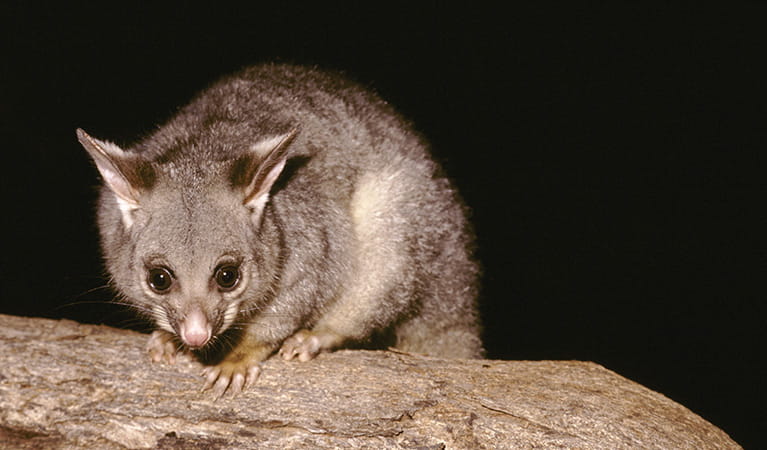
Common brushtail possum (Trichosurus vulpecula)
One of the most widespread of Australian tree-dwelling marsupials, the common brushtail possum is found across most of NSW in woodlands, rainforests and urban areas. With strong claws, a prehensile tail and opposable digits, these native Australian animals are well-adapted for life amongst the trees.
-

Common ringtail possum (Pseudocheirus peregrinus)
Commonly found in forests, woodlands and leafy gardens across eastern NSW, the Australian ringtail possum is a tree-dwelling marsupial. With a powerful tail perfectly adapted to grasp objects, it forages in trees for eucalypt leaves, flowers and fruit.
-
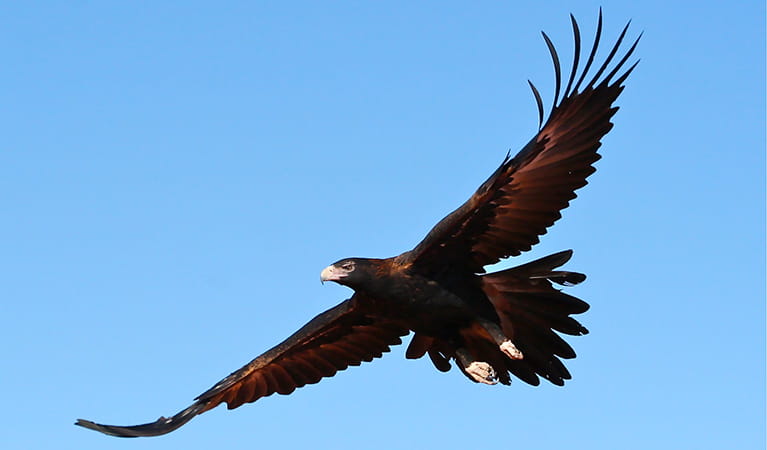
Wedge-tailed eagle (Aquila audax)
With a wingspan of up to 2.5m, the wedge-tailed eagle is Australia’s largest bird of prey. These Australian animals are found in woodlands across NSW, and have the ability to soar to heights of over 2km. If you’re bird watching, look out for the distinctive diamond-shaped tail of the eagle.
-

Swamp wallaby (Wallabia bicolor)
The swamp wallaby, also known as the black wallaby or black pademelon, lives in the dense understorey of rainforests, woodlands and dry sclerophyll forest along eastern Australia. This unique Australian macropod has a dark black-grey coat with a distinctive light-coloured cheek stripe.
-
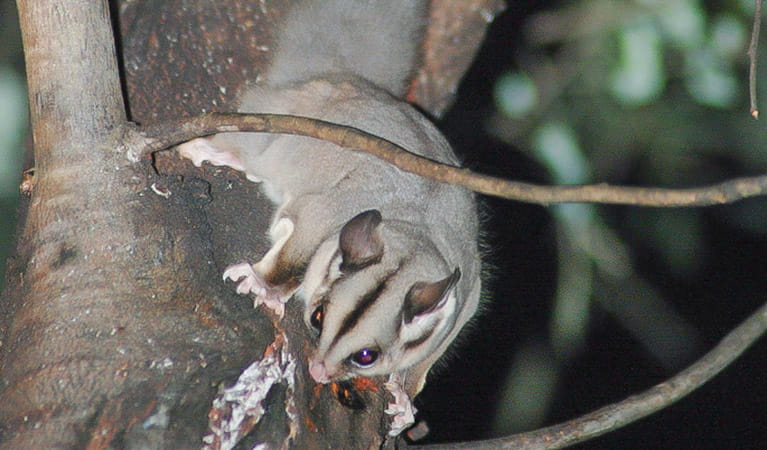
Sugar glider (Petaurus breviceps)
The sugar glider is a tree-dwelling Australian native marsupial, found in tall eucalypt forests and woodlands along eastern NSW. The nocturnal sugar glider feeds on insects and birds, and satisfies its sweet tooth with nectar and pollens.
-

Superb lyrebird (Menura novaehollandiae)
With a complex mimicking call and an elaborate courtship dance to match, the superb lyrebird is one of the most spectacular Australian animals. A bird watching must-see, the superb lyrebird can be found in rainforests and wet woodlands across eastern NSW and Victoria.
-
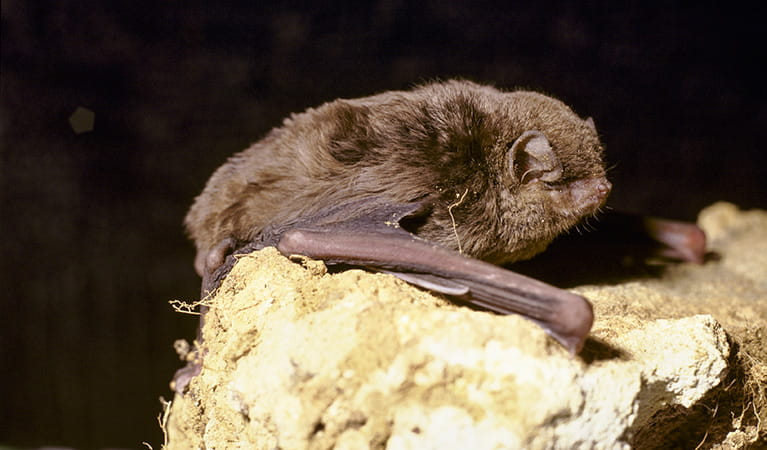
Eastern bentwing-bat (Miniopterus schreibersii oceanensis)
Eastern bentwing-bats congregate in caves across the east and north-west coasts of Australia, in colonies of up to 150,000. These small Australian animals weigh around 13-17g and can reach speeds of up to 50km per hour. Eastern bentwing-bats use both sight and echolocation to catch small insects mid-air.
Plants
-
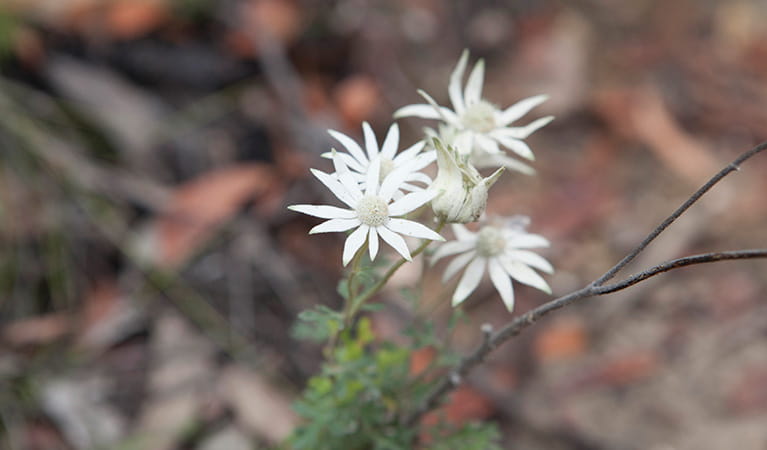
Flannel flower (Actinotus helianthi)
The delicate flannel flower is so named because of the soft woolly feel of the plant. Growing in the NSW south coast region, extending to Narrabri in the Central West and up to south-east Queensland, its white or pink flowers bloom all year long, with an extra burst of colour in the spring.
-
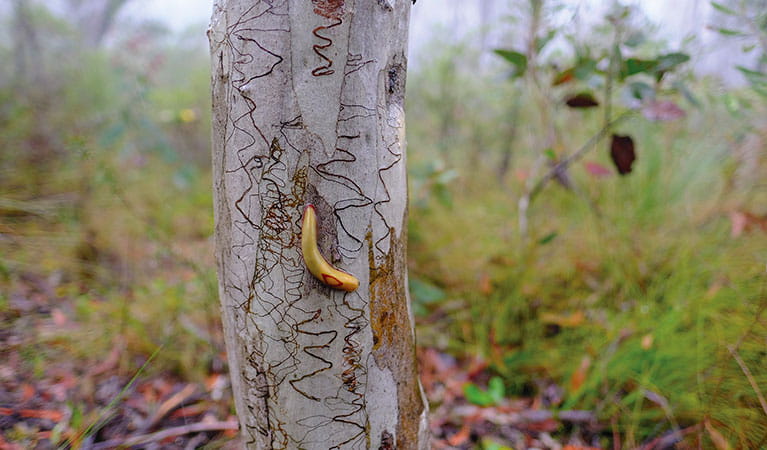
Scribbly gum (Eucalyptus haemastoma)
Easily identifiable Australian native plants, scribbly gum trees are found throughout NSW coastal plains and hills in the Sydney region. The most distinctive features of this eucalypt are the ‘scribbles’ made by moth larva as it tunnels between the layers of bark.
-

Grass tree (Xanthorrea spp.)
An iconic part of the Australian landscape, the grass tree is widespread across eastern NSW. These Australian native plants have a thick fire-blackened trunk and long spiked leaves. They are found in heath and open forests across eastern NSW. The grass tree grows 1-5m in height and produces striking white-flowered spikes which grow up to 1m long.
-
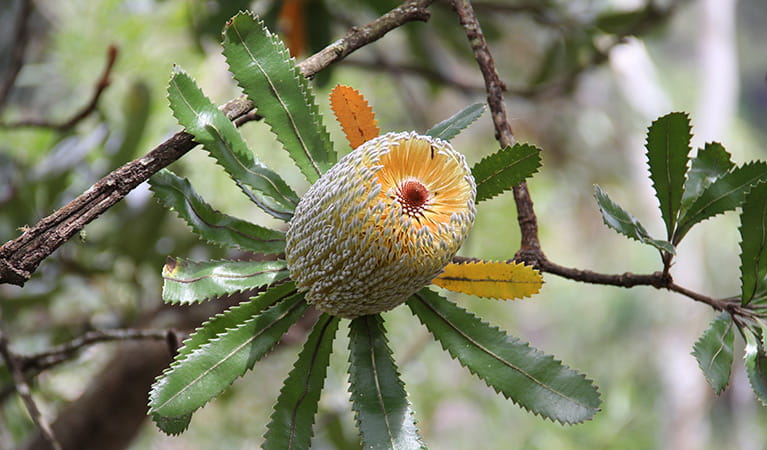
Old man banksia (Banksia serrata)
Hardy Australian native plants, old man banksias can be found along the coast, and in the dry sclerophyll forests and sandstone mountain ranges of NSW. With roughened bark and gnarled limbs, they produce a distinctive cylindrical yellow-green banksia flower which blossoms from summer to early autumn.
-
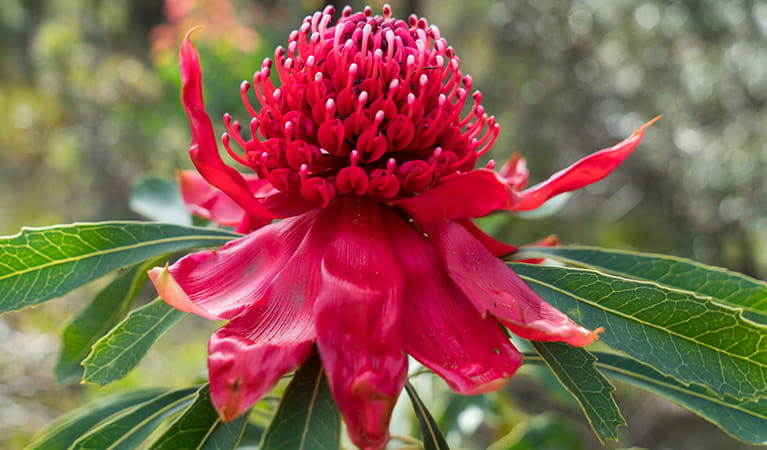
Waratah (Telopea speciosissima)
The beautiful waratah is not only the NSW floral emblem, it's also one of the best-known Australian native plants. This iconic Australian bush flower can be found on sandstone ridges around Sydney, in nearby mountain ranges and on the NSW South Coast. The waratah has a vibrant crimson flowerhead, measuring up to 15cm across, and blossoms in spring.
-
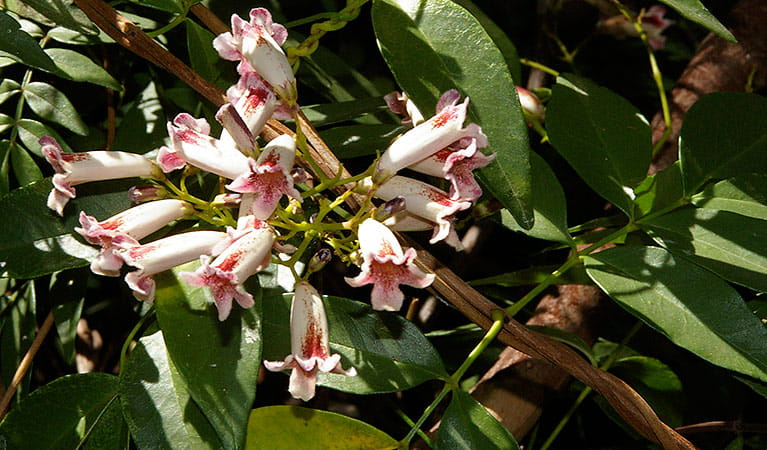
Wonga wonga vine (Pandorea pandorana)
The wonga wonga vine is a widespread vigorous climber usually found along eastern Australia. A variation of the plant occurs in the central desert, where it resembles a sprawling shrub. One of the more common Australian native plants, the wonga wonga vine produces bell-shaped white or yellow flowers in the spring, followed by a large oblong-shaped seed pod.
Look out for...
Sugar glider
Petaurus breviceps
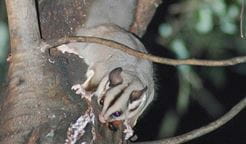
The sugar glider is a tree-dwelling Australian native marsupial, found in tall eucalypt forests and woodlands along eastern NSW. The nocturnal sugar glider feeds on insects and birds, and satisfies its sweet tooth with nectar and pollens.